Product/Service Development: Sainsbury's Lifecycle Management
VerifiedAdded on 2023/06/09
|9
|2611
|120
Report
AI Summary
This report examines product and service development at Sainsbury's, focusing on the processes involved in new product creation, including idea generation, screening, concept development, and marketing strategy. It evaluates the product lifecycle stages—introduction, growth, maturity, and decline—using Sainsbury's new 'recycled plastic T-shirt' as an example. The report also assesses strategies for managing these lifecycle stages, recommending a 'trading up' product line management approach to enhance product quality and pricing. It concludes by highlighting the importance of continuous market research, planning, and prototyping to ensure product success and competitiveness in the market. This resource is available for students looking for solved assignments and study materials on Desklib.

PRODUCT AND SERVICE
DEVELOPMENT
DEVELOPMENT
Paraphrase This Document
Need a fresh take? Get an instant paraphrase of this document with our AI Paraphraser

TABLE OF CONTENTS
INTRODUCTION...........................................................................................................................3
MAIN BODY...................................................................................................................................3
Organisational overview..............................................................................................................3
Process involves in development of products and services and consumer integration level.......3
Evaluation of range of products and services related to lifecycle stage......................................4
Evaluation of managing the lifecycle stages and justification for the selected product line
management choice......................................................................................................................6
Choosing one product line management choice:.........................................................................6
CONCLUSION................................................................................................................................7
REFERENCES................................................................................................................................9
INTRODUCTION...........................................................................................................................3
MAIN BODY...................................................................................................................................3
Organisational overview..............................................................................................................3
Process involves in development of products and services and consumer integration level.......3
Evaluation of range of products and services related to lifecycle stage......................................4
Evaluation of managing the lifecycle stages and justification for the selected product line
management choice......................................................................................................................6
Choosing one product line management choice:.........................................................................6
CONCLUSION................................................................................................................................7
REFERENCES................................................................................................................................9

INTRODUCTION
Product and service development also termed as the new product management which
comprises of series of stages that highlights the conceptualisation, designing, manufacturing of
the new product and services (Francisco, Junior and Sant’Anna, 2020). Product development
plays a significant role for the organisation as it ensures the better values for the potential
consumers as well as make sure that there are such demands that company’s products are at
possible highest quality before taking the product into market. Sainsbury a second largest
supermarket chain of United Kingdom, headquarter is present in London, England company
deals with variety of products and have greater market share. Following report will cover the
product development of firm which discuss the processes which involves within new product
development. It also covers the life cycle stage of products and covers the requirement of product
line management for individual product.
MAIN BODY
Organisational overview
Sainsbury a retail supermarket chain which have diversification in their product, company
operates globally and considered as the largest UK retailer of groceries. Firm owns the Argos,
nectar, Sainsbury’s Bank brands company is committed with sustainability and to deliver
valuable and better products to consumers (Zheng and et.al 2019). Company sells groceries,
clothing, homewares and other financial or electrical services. Their focus on quality,
sustainability and provenance makes them unique from other brands their offering makes the
consumer to buy their products and services.
For this report specific new product have been selected which is “recycled plastic T-shirt”
which is sustainable and do not cause any harm to consumer. It will be available at affordable
price and also available in customised size so every consumer can avail it.
Process involves in development of products and services and consumer integration level
New product always plays a crucial point for the success of the business where the
organisation aims to carry out proper market research to identify the factors that can be easily
incorporated with the development process. It is also a series of stages where it comprises of the
Product and service development also termed as the new product management which
comprises of series of stages that highlights the conceptualisation, designing, manufacturing of
the new product and services (Francisco, Junior and Sant’Anna, 2020). Product development
plays a significant role for the organisation as it ensures the better values for the potential
consumers as well as make sure that there are such demands that company’s products are at
possible highest quality before taking the product into market. Sainsbury a second largest
supermarket chain of United Kingdom, headquarter is present in London, England company
deals with variety of products and have greater market share. Following report will cover the
product development of firm which discuss the processes which involves within new product
development. It also covers the life cycle stage of products and covers the requirement of product
line management for individual product.
MAIN BODY
Organisational overview
Sainsbury a retail supermarket chain which have diversification in their product, company
operates globally and considered as the largest UK retailer of groceries. Firm owns the Argos,
nectar, Sainsbury’s Bank brands company is committed with sustainability and to deliver
valuable and better products to consumers (Zheng and et.al 2019). Company sells groceries,
clothing, homewares and other financial or electrical services. Their focus on quality,
sustainability and provenance makes them unique from other brands their offering makes the
consumer to buy their products and services.
For this report specific new product have been selected which is “recycled plastic T-shirt”
which is sustainable and do not cause any harm to consumer. It will be available at affordable
price and also available in customised size so every consumer can avail it.
Process involves in development of products and services and consumer integration level
New product always plays a crucial point for the success of the business where the
organisation aims to carry out proper market research to identify the factors that can be easily
incorporated with the development process. It is also a series of stages where it comprises of the
⊘ This is a preview!⊘
Do you want full access?
Subscribe today to unlock all pages.

Trusted by 1+ million students worldwide
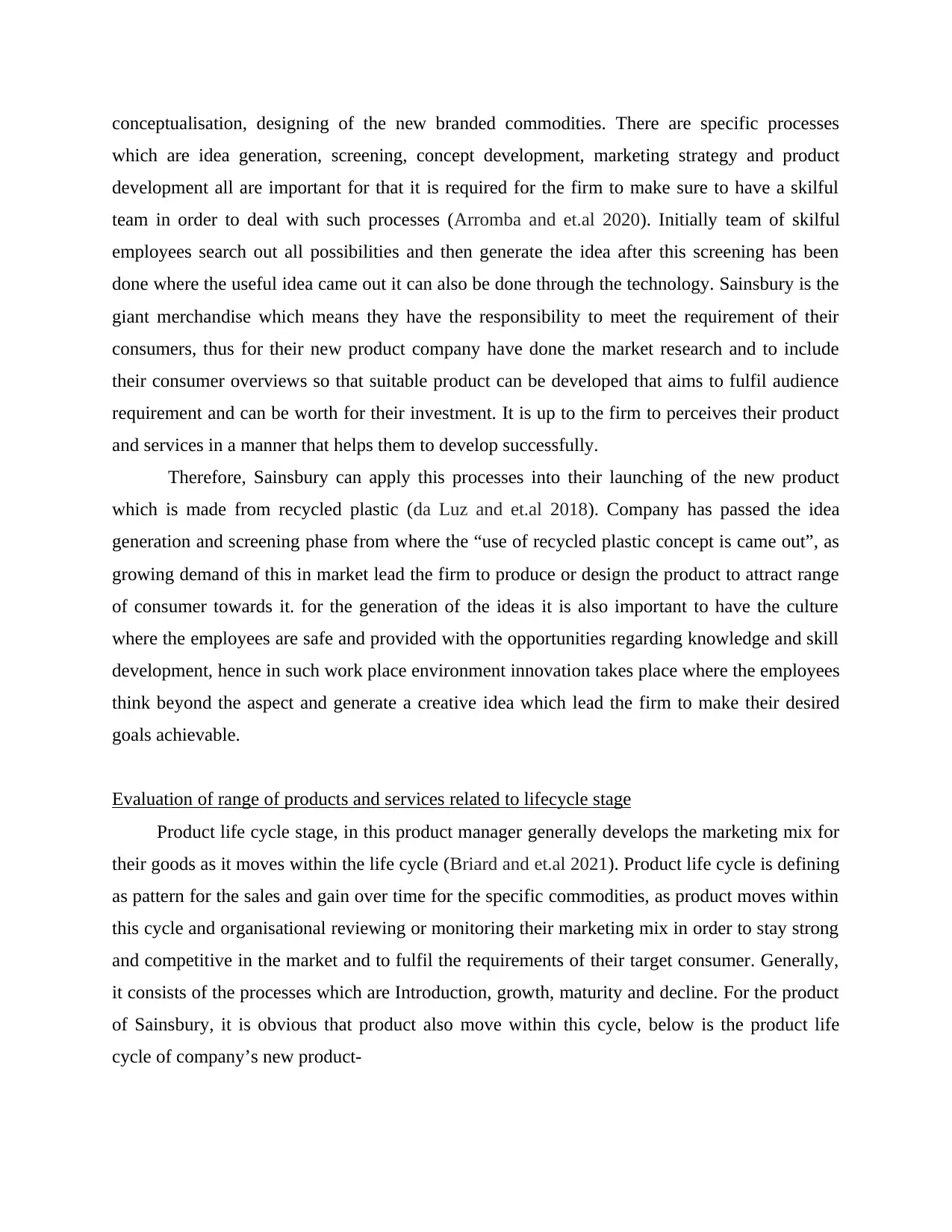
conceptualisation, designing of the new branded commodities. There are specific processes
which are idea generation, screening, concept development, marketing strategy and product
development all are important for that it is required for the firm to make sure to have a skilful
team in order to deal with such processes (Arromba and et.al 2020). Initially team of skilful
employees search out all possibilities and then generate the idea after this screening has been
done where the useful idea came out it can also be done through the technology. Sainsbury is the
giant merchandise which means they have the responsibility to meet the requirement of their
consumers, thus for their new product company have done the market research and to include
their consumer overviews so that suitable product can be developed that aims to fulfil audience
requirement and can be worth for their investment. It is up to the firm to perceives their product
and services in a manner that helps them to develop successfully.
Therefore, Sainsbury can apply this processes into their launching of the new product
which is made from recycled plastic (da Luz and et.al 2018). Company has passed the idea
generation and screening phase from where the “use of recycled plastic concept is came out”, as
growing demand of this in market lead the firm to produce or design the product to attract range
of consumer towards it. for the generation of the ideas it is also important to have the culture
where the employees are safe and provided with the opportunities regarding knowledge and skill
development, hence in such work place environment innovation takes place where the employees
think beyond the aspect and generate a creative idea which lead the firm to make their desired
goals achievable.
Evaluation of range of products and services related to lifecycle stage
Product life cycle stage, in this product manager generally develops the marketing mix for
their goods as it moves within the life cycle (Briard and et.al 2021). Product life cycle is defining
as pattern for the sales and gain over time for the specific commodities, as product moves within
this cycle and organisational reviewing or monitoring their marketing mix in order to stay strong
and competitive in the market and to fulfil the requirements of their target consumer. Generally,
it consists of the processes which are Introduction, growth, maturity and decline. For the product
of Sainsbury, it is obvious that product also move within this cycle, below is the product life
cycle of company’s new product-
which are idea generation, screening, concept development, marketing strategy and product
development all are important for that it is required for the firm to make sure to have a skilful
team in order to deal with such processes (Arromba and et.al 2020). Initially team of skilful
employees search out all possibilities and then generate the idea after this screening has been
done where the useful idea came out it can also be done through the technology. Sainsbury is the
giant merchandise which means they have the responsibility to meet the requirement of their
consumers, thus for their new product company have done the market research and to include
their consumer overviews so that suitable product can be developed that aims to fulfil audience
requirement and can be worth for their investment. It is up to the firm to perceives their product
and services in a manner that helps them to develop successfully.
Therefore, Sainsbury can apply this processes into their launching of the new product
which is made from recycled plastic (da Luz and et.al 2018). Company has passed the idea
generation and screening phase from where the “use of recycled plastic concept is came out”, as
growing demand of this in market lead the firm to produce or design the product to attract range
of consumer towards it. for the generation of the ideas it is also important to have the culture
where the employees are safe and provided with the opportunities regarding knowledge and skill
development, hence in such work place environment innovation takes place where the employees
think beyond the aspect and generate a creative idea which lead the firm to make their desired
goals achievable.
Evaluation of range of products and services related to lifecycle stage
Product life cycle stage, in this product manager generally develops the marketing mix for
their goods as it moves within the life cycle (Briard and et.al 2021). Product life cycle is defining
as pattern for the sales and gain over time for the specific commodities, as product moves within
this cycle and organisational reviewing or monitoring their marketing mix in order to stay strong
and competitive in the market and to fulfil the requirements of their target consumer. Generally,
it consists of the processes which are Introduction, growth, maturity and decline. For the product
of Sainsbury, it is obvious that product also move within this cycle, below is the product life
cycle of company’s new product-
Paraphrase This Document
Need a fresh take? Get an instant paraphrase of this document with our AI Paraphraser

Introduction: It is the initial stage where it shows that initially product is developed and ready
to be launched in the market. it also means that product has completed all its testing then after
passing all the criteria and now it’s being ready to mark its presence in the market and to
generate the sales for the product. Launching of the product is high stakes time span within
product life cycle although it does not generally mark the good’s success. Hence Sainsbury
company need to make sure that they are deploying better marketing and promotional activities
for the product, initially marketing plays a significant role, therefore they should also focus on
their marketing activity regarding their new “Recycle plastic t-shirt” product.
Growth: During growth phase consumer started taking interest into product and often make the
decision to buy it. in such period of time product started growing eventually its sales also
increases (Submitter, Vetrova and Ivanova, 2021). It started to draw more attention and pull
more revenues, if the competition is relatively high then the firm still have the potential to invest
in its advertising in order to beat the competitors. Therefore, Sainsbury also need to make sure
that their product is growing in the market and to beat its competition they continually need to
focus on its promotion.
Maturity: After growing phase eventually product reaches to the maturity stage where its sales
started decreasing and also indicates the saturated market. pricing in this phase tends to be
competitive thus revenue margin started shrinking and prices also started falling because of
external forces like lower demand and other intense competition. Thus in such it is important for
Sainsbury to carry out the target marketing and also they can proceed to increase their
distribution channels for the demand of the product.
Decline: Organisation tries to keep their product into the maturity stage by implementing all
alternatives but decline is inevitable for every product. In this phase product demand is declined
in market where consumer is no longer seem as interested in buying the product, company
started experience losses in particular product. Hence for Sainsbury if their new recycled plastic
t-shirt enters in this stage then it is important for them to decrease their cost over the product and
to identify the different use of that particular product.
to be launched in the market. it also means that product has completed all its testing then after
passing all the criteria and now it’s being ready to mark its presence in the market and to
generate the sales for the product. Launching of the product is high stakes time span within
product life cycle although it does not generally mark the good’s success. Hence Sainsbury
company need to make sure that they are deploying better marketing and promotional activities
for the product, initially marketing plays a significant role, therefore they should also focus on
their marketing activity regarding their new “Recycle plastic t-shirt” product.
Growth: During growth phase consumer started taking interest into product and often make the
decision to buy it. in such period of time product started growing eventually its sales also
increases (Submitter, Vetrova and Ivanova, 2021). It started to draw more attention and pull
more revenues, if the competition is relatively high then the firm still have the potential to invest
in its advertising in order to beat the competitors. Therefore, Sainsbury also need to make sure
that their product is growing in the market and to beat its competition they continually need to
focus on its promotion.
Maturity: After growing phase eventually product reaches to the maturity stage where its sales
started decreasing and also indicates the saturated market. pricing in this phase tends to be
competitive thus revenue margin started shrinking and prices also started falling because of
external forces like lower demand and other intense competition. Thus in such it is important for
Sainsbury to carry out the target marketing and also they can proceed to increase their
distribution channels for the demand of the product.
Decline: Organisation tries to keep their product into the maturity stage by implementing all
alternatives but decline is inevitable for every product. In this phase product demand is declined
in market where consumer is no longer seem as interested in buying the product, company
started experience losses in particular product. Hence for Sainsbury if their new recycled plastic
t-shirt enters in this stage then it is important for them to decrease their cost over the product and
to identify the different use of that particular product.
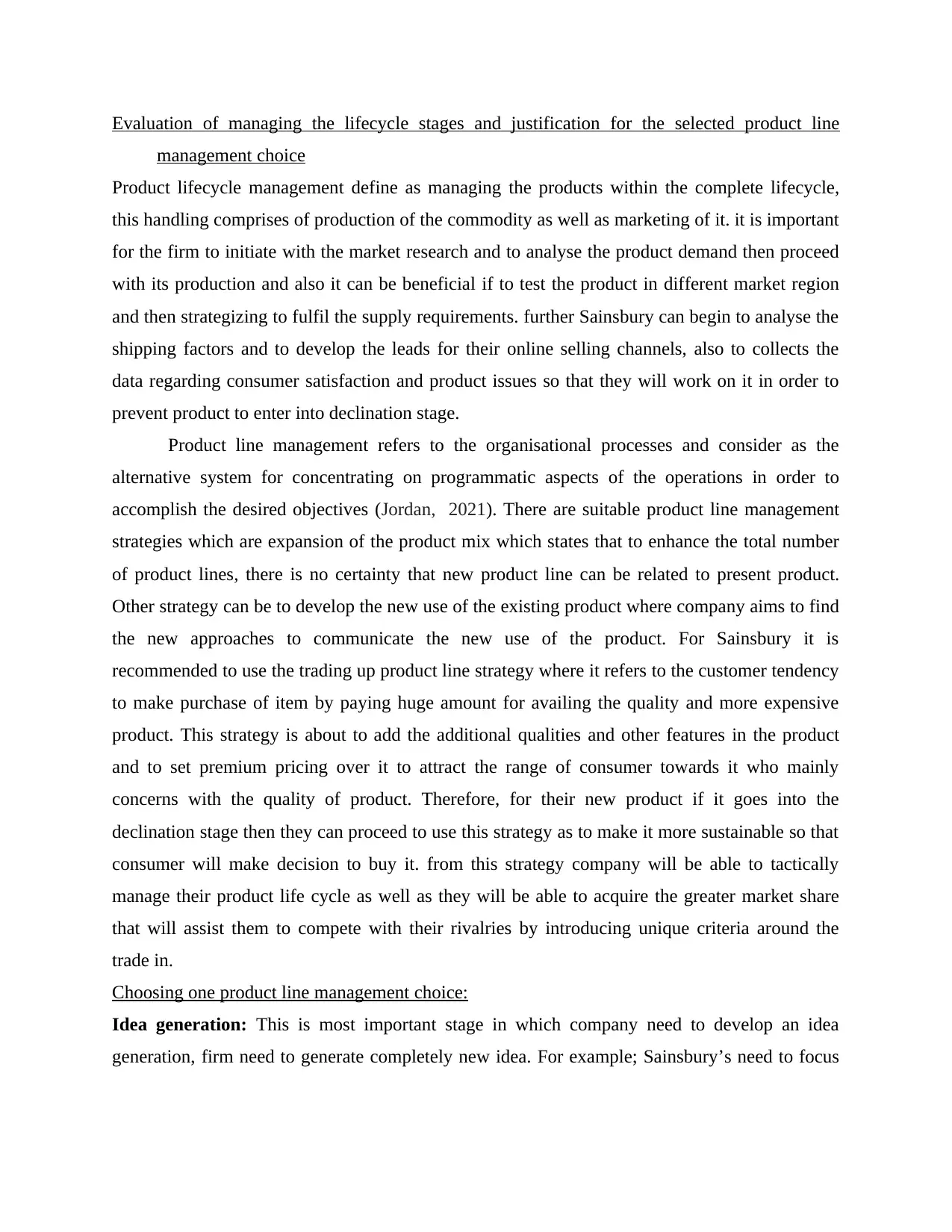
Evaluation of managing the lifecycle stages and justification for the selected product line
management choice
Product lifecycle management define as managing the products within the complete lifecycle,
this handling comprises of production of the commodity as well as marketing of it. it is important
for the firm to initiate with the market research and to analyse the product demand then proceed
with its production and also it can be beneficial if to test the product in different market region
and then strategizing to fulfil the supply requirements. further Sainsbury can begin to analyse the
shipping factors and to develop the leads for their online selling channels, also to collects the
data regarding consumer satisfaction and product issues so that they will work on it in order to
prevent product to enter into declination stage.
Product line management refers to the organisational processes and consider as the
alternative system for concentrating on programmatic aspects of the operations in order to
accomplish the desired objectives (Jordan, 2021). There are suitable product line management
strategies which are expansion of the product mix which states that to enhance the total number
of product lines, there is no certainty that new product line can be related to present product.
Other strategy can be to develop the new use of the existing product where company aims to find
the new approaches to communicate the new use of the product. For Sainsbury it is
recommended to use the trading up product line strategy where it refers to the customer tendency
to make purchase of item by paying huge amount for availing the quality and more expensive
product. This strategy is about to add the additional qualities and other features in the product
and to set premium pricing over it to attract the range of consumer towards it who mainly
concerns with the quality of product. Therefore, for their new product if it goes into the
declination stage then they can proceed to use this strategy as to make it more sustainable so that
consumer will make decision to buy it. from this strategy company will be able to tactically
manage their product life cycle as well as they will be able to acquire the greater market share
that will assist them to compete with their rivalries by introducing unique criteria around the
trade in.
Choosing one product line management choice:
Idea generation: This is most important stage in which company need to develop an idea
generation, firm need to generate completely new idea. For example; Sainsbury’s need to focus
management choice
Product lifecycle management define as managing the products within the complete lifecycle,
this handling comprises of production of the commodity as well as marketing of it. it is important
for the firm to initiate with the market research and to analyse the product demand then proceed
with its production and also it can be beneficial if to test the product in different market region
and then strategizing to fulfil the supply requirements. further Sainsbury can begin to analyse the
shipping factors and to develop the leads for their online selling channels, also to collects the
data regarding consumer satisfaction and product issues so that they will work on it in order to
prevent product to enter into declination stage.
Product line management refers to the organisational processes and consider as the
alternative system for concentrating on programmatic aspects of the operations in order to
accomplish the desired objectives (Jordan, 2021). There are suitable product line management
strategies which are expansion of the product mix which states that to enhance the total number
of product lines, there is no certainty that new product line can be related to present product.
Other strategy can be to develop the new use of the existing product where company aims to find
the new approaches to communicate the new use of the product. For Sainsbury it is
recommended to use the trading up product line strategy where it refers to the customer tendency
to make purchase of item by paying huge amount for availing the quality and more expensive
product. This strategy is about to add the additional qualities and other features in the product
and to set premium pricing over it to attract the range of consumer towards it who mainly
concerns with the quality of product. Therefore, for their new product if it goes into the
declination stage then they can proceed to use this strategy as to make it more sustainable so that
consumer will make decision to buy it. from this strategy company will be able to tactically
manage their product life cycle as well as they will be able to acquire the greater market share
that will assist them to compete with their rivalries by introducing unique criteria around the
trade in.
Choosing one product line management choice:
Idea generation: This is most important stage in which company need to develop an idea
generation, firm need to generate completely new idea. For example; Sainsbury’s need to focus
⊘ This is a preview!⊘
Do you want full access?
Subscribe today to unlock all pages.

Trusted by 1+ million students worldwide
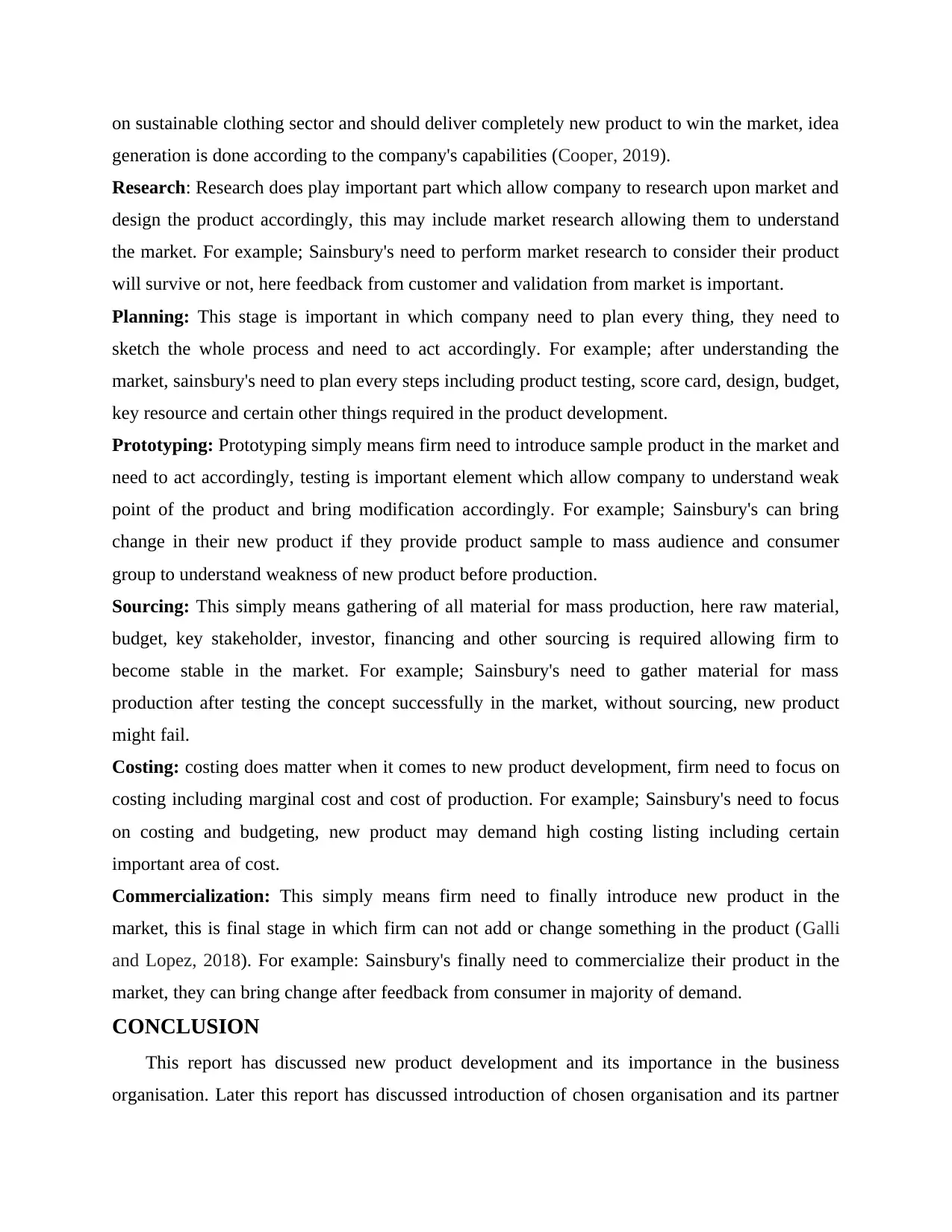
on sustainable clothing sector and should deliver completely new product to win the market, idea
generation is done according to the company's capabilities (Cooper, 2019).
Research: Research does play important part which allow company to research upon market and
design the product accordingly, this may include market research allowing them to understand
the market. For example; Sainsbury's need to perform market research to consider their product
will survive or not, here feedback from customer and validation from market is important.
Planning: This stage is important in which company need to plan every thing, they need to
sketch the whole process and need to act accordingly. For example; after understanding the
market, sainsbury's need to plan every steps including product testing, score card, design, budget,
key resource and certain other things required in the product development.
Prototyping: Prototyping simply means firm need to introduce sample product in the market and
need to act accordingly, testing is important element which allow company to understand weak
point of the product and bring modification accordingly. For example; Sainsbury's can bring
change in their new product if they provide product sample to mass audience and consumer
group to understand weakness of new product before production.
Sourcing: This simply means gathering of all material for mass production, here raw material,
budget, key stakeholder, investor, financing and other sourcing is required allowing firm to
become stable in the market. For example; Sainsbury's need to gather material for mass
production after testing the concept successfully in the market, without sourcing, new product
might fail.
Costing: costing does matter when it comes to new product development, firm need to focus on
costing including marginal cost and cost of production. For example; Sainsbury's need to focus
on costing and budgeting, new product may demand high costing listing including certain
important area of cost.
Commercialization: This simply means firm need to finally introduce new product in the
market, this is final stage in which firm can not add or change something in the product (Galli
and Lopez, 2018). For example: Sainsbury's finally need to commercialize their product in the
market, they can bring change after feedback from consumer in majority of demand.
CONCLUSION
This report has discussed new product development and its importance in the business
organisation. Later this report has discussed introduction of chosen organisation and its partner
generation is done according to the company's capabilities (Cooper, 2019).
Research: Research does play important part which allow company to research upon market and
design the product accordingly, this may include market research allowing them to understand
the market. For example; Sainsbury's need to perform market research to consider their product
will survive or not, here feedback from customer and validation from market is important.
Planning: This stage is important in which company need to plan every thing, they need to
sketch the whole process and need to act accordingly. For example; after understanding the
market, sainsbury's need to plan every steps including product testing, score card, design, budget,
key resource and certain other things required in the product development.
Prototyping: Prototyping simply means firm need to introduce sample product in the market and
need to act accordingly, testing is important element which allow company to understand weak
point of the product and bring modification accordingly. For example; Sainsbury's can bring
change in their new product if they provide product sample to mass audience and consumer
group to understand weakness of new product before production.
Sourcing: This simply means gathering of all material for mass production, here raw material,
budget, key stakeholder, investor, financing and other sourcing is required allowing firm to
become stable in the market. For example; Sainsbury's need to gather material for mass
production after testing the concept successfully in the market, without sourcing, new product
might fail.
Costing: costing does matter when it comes to new product development, firm need to focus on
costing including marginal cost and cost of production. For example; Sainsbury's need to focus
on costing and budgeting, new product may demand high costing listing including certain
important area of cost.
Commercialization: This simply means firm need to finally introduce new product in the
market, this is final stage in which firm can not add or change something in the product (Galli
and Lopez, 2018). For example: Sainsbury's finally need to commercialize their product in the
market, they can bring change after feedback from consumer in majority of demand.
CONCLUSION
This report has discussed new product development and its importance in the business
organisation. Later this report has discussed introduction of chosen organisation and its partner
Paraphrase This Document
Need a fresh take? Get an instant paraphrase of this document with our AI Paraphraser
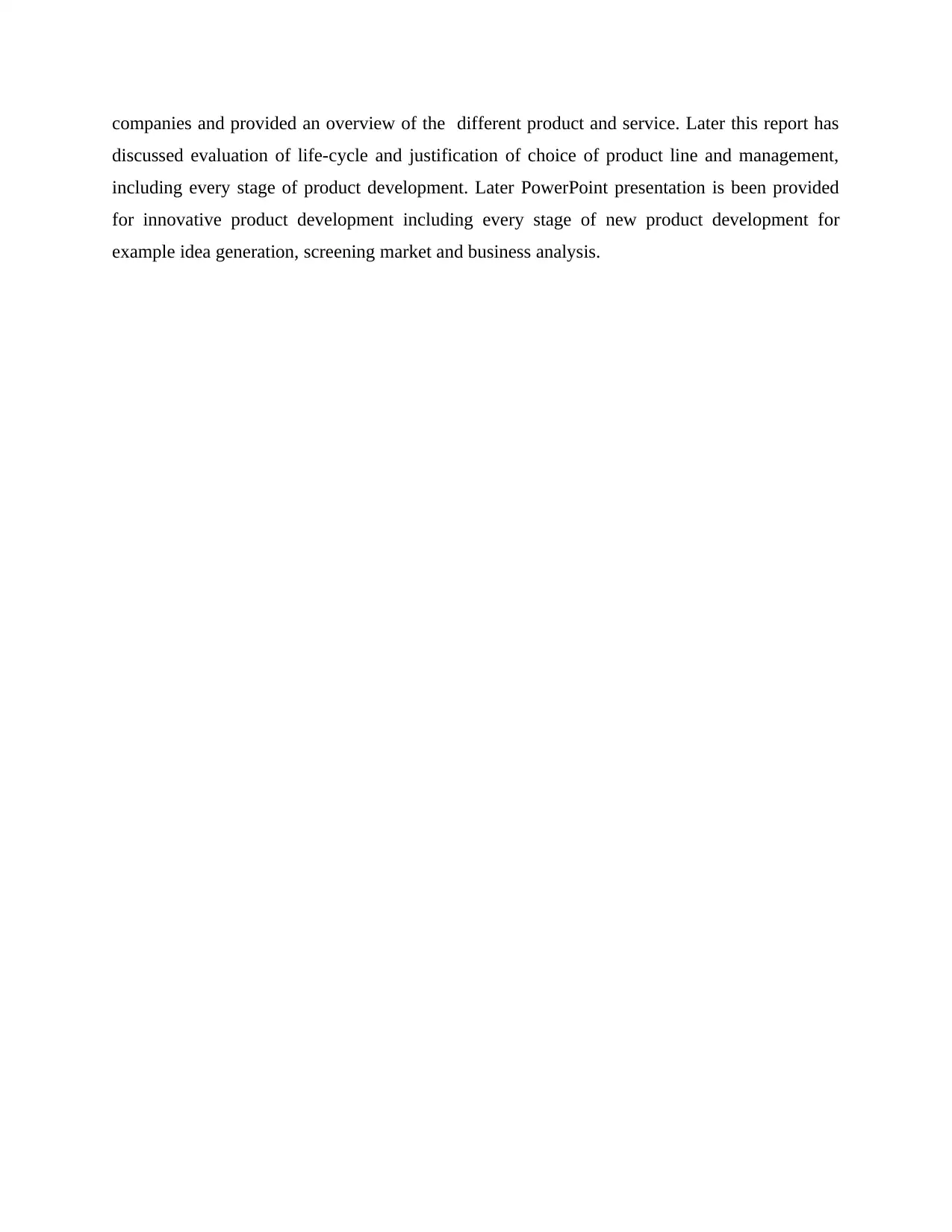
companies and provided an overview of the different product and service. Later this report has
discussed evaluation of life-cycle and justification of choice of product line and management,
including every stage of product development. Later PowerPoint presentation is been provided
for innovative product development including every stage of new product development for
example idea generation, screening market and business analysis.
discussed evaluation of life-cycle and justification of choice of product line and management,
including every stage of product development. Later PowerPoint presentation is been provided
for innovative product development including every stage of new product development for
example idea generation, screening market and business analysis.
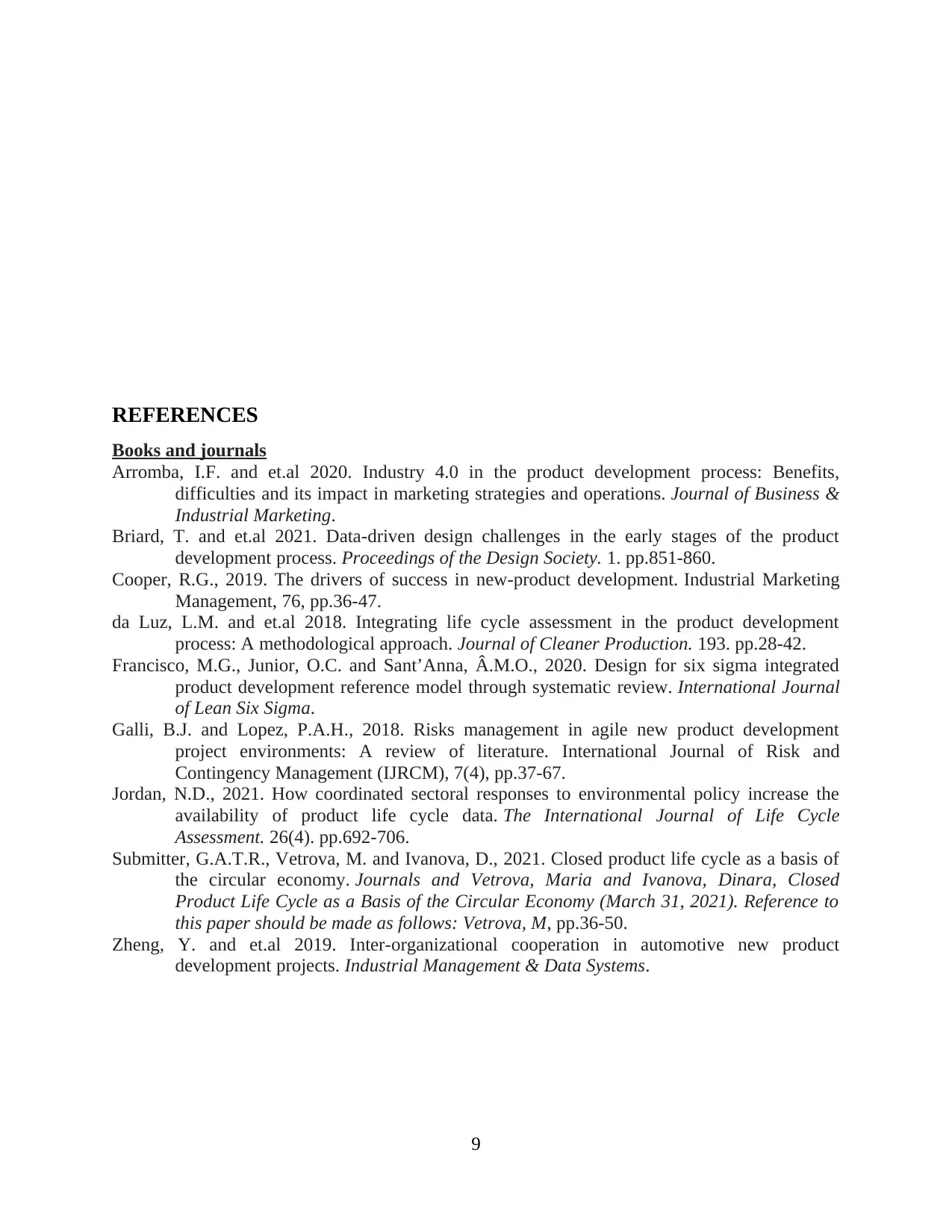
REFERENCES
Books and journals
Arromba, I.F. and et.al 2020. Industry 4.0 in the product development process: Benefits,
difficulties and its impact in marketing strategies and operations. Journal of Business &
Industrial Marketing.
Briard, T. and et.al 2021. Data-driven design challenges in the early stages of the product
development process. Proceedings of the Design Society. 1. pp.851-860.
Cooper, R.G., 2019. The drivers of success in new-product development. Industrial Marketing
Management, 76, pp.36-47.
da Luz, L.M. and et.al 2018. Integrating life cycle assessment in the product development
process: A methodological approach. Journal of Cleaner Production. 193. pp.28-42.
Francisco, M.G., Junior, O.C. and Sant’Anna, Â.M.O., 2020. Design for six sigma integrated
product development reference model through systematic review. International Journal
of Lean Six Sigma.
Galli, B.J. and Lopez, P.A.H., 2018. Risks management in agile new product development
project environments: A review of literature. International Journal of Risk and
Contingency Management (IJRCM), 7(4), pp.37-67.
Jordan, N.D., 2021. How coordinated sectoral responses to environmental policy increase the
availability of product life cycle data. The International Journal of Life Cycle
Assessment. 26(4). pp.692-706.
Submitter, G.A.T.R., Vetrova, M. and Ivanova, D., 2021. Closed product life cycle as a basis of
the circular economy. Journals and Vetrova, Maria and Ivanova, Dinara, Closed
Product Life Cycle as a Basis of the Circular Economy (March 31, 2021). Reference to
this paper should be made as follows: Vetrova, M, pp.36-50.
Zheng, Y. and et.al 2019. Inter-organizational cooperation in automotive new product
development projects. Industrial Management & Data Systems.
9
Books and journals
Arromba, I.F. and et.al 2020. Industry 4.0 in the product development process: Benefits,
difficulties and its impact in marketing strategies and operations. Journal of Business &
Industrial Marketing.
Briard, T. and et.al 2021. Data-driven design challenges in the early stages of the product
development process. Proceedings of the Design Society. 1. pp.851-860.
Cooper, R.G., 2019. The drivers of success in new-product development. Industrial Marketing
Management, 76, pp.36-47.
da Luz, L.M. and et.al 2018. Integrating life cycle assessment in the product development
process: A methodological approach. Journal of Cleaner Production. 193. pp.28-42.
Francisco, M.G., Junior, O.C. and Sant’Anna, Â.M.O., 2020. Design for six sigma integrated
product development reference model through systematic review. International Journal
of Lean Six Sigma.
Galli, B.J. and Lopez, P.A.H., 2018. Risks management in agile new product development
project environments: A review of literature. International Journal of Risk and
Contingency Management (IJRCM), 7(4), pp.37-67.
Jordan, N.D., 2021. How coordinated sectoral responses to environmental policy increase the
availability of product life cycle data. The International Journal of Life Cycle
Assessment. 26(4). pp.692-706.
Submitter, G.A.T.R., Vetrova, M. and Ivanova, D., 2021. Closed product life cycle as a basis of
the circular economy. Journals and Vetrova, Maria and Ivanova, Dinara, Closed
Product Life Cycle as a Basis of the Circular Economy (March 31, 2021). Reference to
this paper should be made as follows: Vetrova, M, pp.36-50.
Zheng, Y. and et.al 2019. Inter-organizational cooperation in automotive new product
development projects. Industrial Management & Data Systems.
9
⊘ This is a preview!⊘
Do you want full access?
Subscribe today to unlock all pages.

Trusted by 1+ million students worldwide
1 out of 9
Related Documents
Your All-in-One AI-Powered Toolkit for Academic Success.
+13062052269
info@desklib.com
Available 24*7 on WhatsApp / Email
![[object Object]](/_next/static/media/star-bottom.7253800d.svg)
Unlock your academic potential
Copyright © 2020–2025 A2Z Services. All Rights Reserved. Developed and managed by ZUCOL.





